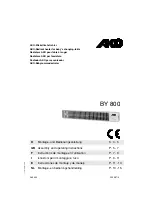
hand hole for ease of inspection, cleanout and service. An optional manhole may be specified for a
greater ease of inspection. The interior of the storage tank is glass lined and fired insure a molecular
fusing of glass and steel to protect the steel base metal against corrosion. A magnesium anode(s) is standard
to enhance the protection of the substrate metal of the tank.
RELIEF VALVE:
This water heater is supplied with a temperature and pressure relief valve(s) sized in accordance with
ASME Boiler and Pressure Vessel Code, Section IV. Some water heaters may be supplied with an
optional pressure only relief valve. The relief valve(s) is installed in the vertical position and mounted in
the tapping provided in the storage tank. No valve is to be placed between the relief valve and the water
heater. To prevent water damage, the discharge from the relief valve must be piped to a suitable floor drain
for disposal when relief occurs. No reducing couplings or other restrictions shall be installed in the discharge
line. The discharge line shall allow complete drainage of the valve and line. Relief valves should be manually
operated at least once a year. A relief valve that fails to completely reseat and continues to discharge water
must be immediately replaced with a new, properly sized, temperature and pressure relief valve.
CAUTION:
Avoid contact with hot discharge water. Insure that no one is in front of or around the relief valve
discharge line. Make sure that the extremely hot water manually discharged from the relief valve will
not cause bodily injury or property damage.
THERMAL EXPANSION OF WATER:
A relief valve that discharges periodically may be due to thermal expansion in a closed system. A water
heater installed in a closed system, such as one with a backflow preventer or check valve an installed in the
cold water supply, shall be provided with means to control expansion. Contact the water supplier or local
plumbing inspector on how to correct this situation.
DO NOT plug or cap the relief valve.
CATHODIC PROTECTION:
Hydrogen gas can be produced in a hot water system that has not been used for a long period of time
(generally two weeks or more). Hydrogen gas is extremely flammable. To prevent the possibility of injury
under these conditions, we recommend the hot water faucet be open for several minutes at a sink close to the
water heater before you use any electrical appliance which is connected to the hot water system. If hydrogen
is present, there will be an unusual sound such as air escaping through the pipe as the hot water begins to
flow. There should be no smoking or open flames near the faucet at the time it is open.
ELECTRICAL CONNECTIONS:
All installation procedures involving electric power connection should only be performed by a trained,
certified electrician. The appliance, when installed, must be electrically grounded in accordance with the
requirements of the authority having jurisdiction or in the absence of such requirements, with the latest
edition of the National Electrical Code, NFPA No. 70. When the appliance is installed in Canada, it
must conform to the CAE C22. l , Canadian Electrical Code, Part 1 and/or local Electrical Codes.
9
Summary of Contents for VR-1000-(kW)
Page 21: ...NOTES 22 ...







































